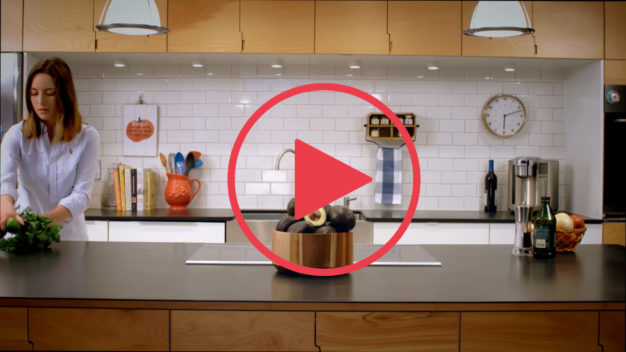The first project I had the chance to work on at One Floor Up back in April was a fun little video for Jeppesen explaining their Avocado Model – an analogy of how their products are built. But the main message of the video wasn’t actually about avocados or highly configurable products, it was all about distraction.
 In order to accomplish this, we created a video of a woman prepping to make guacamole in her kitchen. It was an interactive video of sorts, because as the ingredients were being prepped, elements in the scene were appearing, disappearing, or changing. And the test was to see if the audience noticed. This was a very different marketing approach for our client and for me. I have experience working on interactive museum exhibits, so I was accustomed to designing interactive videos that involved a physical kiosk, where the visitor would touch and play with the content. But on this particular project, a simple video that tested the viewer’s attention is what made it interactive.
In order to accomplish this, we created a video of a woman prepping to make guacamole in her kitchen. It was an interactive video of sorts, because as the ingredients were being prepped, elements in the scene were appearing, disappearing, or changing. And the test was to see if the audience noticed. This was a very different marketing approach for our client and for me. I have experience working on interactive museum exhibits, so I was accustomed to designing interactive videos that involved a physical kiosk, where the visitor would touch and play with the content. But on this particular project, a simple video that tested the viewer’s attention is what made it interactive.
The idea for a “spot the differences” video came from Fiat’s “The Attention Test” where we see a ŠKODA Fabia parked on a city street as the VO talks about its features. Unbeknownst to most viewers, changes are happening in the background as the VO goes on about the car. Quick blips of black throughout the video cause the eye to miss the awning color changing or the lamp post disappearing.
In order to pull off the same visual sleight of hand, without ripping off the reference video, we had to find a creative approach that made sense for our video. We decided to use the talent, our guacamole connoisseur, as our “change-maker.” Every time she walked in front of something or obscured an object, we’d use it as an opportunity to make changes. And though we certainly had our challenges in post-production (how much rotoscoping is too much rotoscoping?), it turned out well and went on to be a very successful video for Jeppesen.
But what made this video so successful? Aside from it being different from Jeppesen’s standard marketing style, interactive videos are becoming an excellent way for businesses to reach their audiences on a deeper level. Instead of talking to the audience, interactive videos have a conversation with the audience and encourage them to interact with the content. The Avocado Video almost mandates viewer engagement by requiring the viewer to pay attention for the duration of the video. And in many cases, it also requires the viewer to go back and watch it again. Because of this, the viewer is more engaged and absorbs the message of the video better than if they were passively watching.
Not only was this video fun to conceptualize and create, it had high levels of engagement internally, which made Jeppesen decide to push the video out on their social channels. It was exciting to watch the success of a new video for Jeppesen and I look forward to more opportunities to play with interactive video content.

